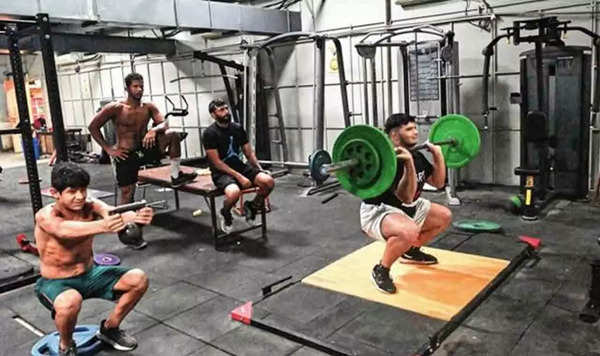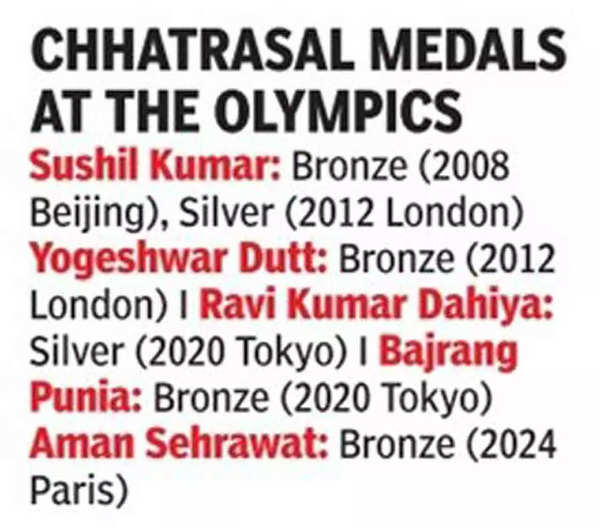[ad_1]
Each does the customary knee-touch of their gurus, earlier than going for his or her warm-ups. The younger boys are fairly excited.There is a broad smile on every of them.
Every week in the past, one amongst them had taken a flight to Paris. On Friday, he turned an Olympic bronze medal winner for the nation. No marvel, everybody on the wrestling academy on Saturday was speaking about Aman Sehrawat. Chhatrasal Akhada is not new to such highs.
Three years in the past, Chhatrasal trainees Ravi Dahiya (silver) and Bajrang Punia (bronze) received Olympic medals in Tokyo. India has eight Olympic medals in wrestling until now, 6 have come from Chhatrasal. It began with Sushil Kumar, who received bronze in 2008 Beijing & then adopted with a silver in ’12 London.
How an unfulfilled dream spurred start of wrestling cradle
Sushil Kumar, skilled on this Chhatrasal Akhada, received bronze in 2008 Beijing after which adopted with a silver in 2012 London. On the similar London Video games, Yogeshwar Dutt bagged a bronze for the nation. It was Satpal Singh – also called Guru Satpal amongst his wards – who’s the founding father of the academy and had skilled the Sushil-Yogeshwar duo.
Again in 1988, Satpal, together with two extra wrestling coaches – Ramphal Mann, a.okay.a. Guru Ramphal, and Pradeep Sharma – began the akhada on the premises of Chhatrasal Stadium in 1988. The stadium is in Mannequin City space of Delhi and is situated someplace between the Mannequin City and Azadpur metro stations. Through the years, the three coaches acquired assist from one other famed wrestling coach Virender Kumar in operating the akhada.
Throughout his days as a wrestler, Satpal emerged as certainly one of India’s premier wrestlers, profitable the nationwide title 16 instances. On the worldwide stage, Satpal received silver on the 1974, 1978 and 1982 Commonwealth Video games. On the Asian Video games, he constantly upgraded the color of his medal, profitable bronze in Tehran 1974, silver in Bangkok 1978 and eventually a gold in New Delhi 1982 in entrance of a house crowd. Throughout this enjoying days, Satpal additionally represented India at two Olympic Video games – Munich 1972 and Moscow 1980. However he didn’t win a medal.

NURSERY OF MEDALLISTS: Budding wrestlers prepare on the Chhatrasal Stadium in Delhi on Saturday
“Ek mann mein tees thi (there was a ache in my coronary heart of not profitable an Olympic medal). That is why I began the akhada on the Chhatrasal Stadium. I wished to churn out Olympic medallists for the nation,” Satpal tells TOI. “Now we’ve got produced not one, however six Olympic medallists.
“Once I went for the Olympics, I had by no means even seen a mat, practising on it was one thing completely totally different. The European international locations, by that point, had been wrestling on mats for years. I wished to alter that. I wished to provide our younger wrestlers an equal alternative to combat on the worldwide stage. We acquired our first mat on the Chhatrasal Akhada in 1992. Sushil, who was a 15-year-old at the moment, skilled on the mat and received a gold on the World Cadet Video games in 1998,” Satpal, now 69, provides.
There are budding wrestlers coaching on the Chhatrasal not solely from Delhi, Haryana and its adjoining areas, however there are some who’ve come from so far as Maharashtra and Madhya Pradesh. Considered one of them, Dhanraj, who hails from Maharashtra, says, “Yahan ki mitti mein kuch alag baat hai (There’s something totally different right here). That is why I’ve come right here to coach.”
Whenever you enter the premises of the akhada, there are giant-sized pictures of Sushil, Ravi, Yogeshwar, Bajrang on the partitions. The Chhatrasal Akhada is to wrestling what Sansarpur in Jalandhar, Punjab, is to hockey or what Azad Maidan in Mumbai is to cricket.
The wrestling academy has now turn into a state-of-the-art facility the place there’s modernity by way of tools, however custom is adopted with regards to the guru-shishya (master-pupil) relationship. There are various cadet-level, youth-level, and in addition senior-level wrestlers coaching on the similar time, below the identical roof, and their motivation is similar. “I need to win an Olympic medal and make my nation proud,” says Mohit Dahiya, 15, who lately received on the Youth Asian championship stage.
“I need to emulate Sushil pehelwaan, Ravi pehelwaan, Aman pehelwaan. They’re my heroes. I do know if I prepare effectively and hearken to my coach, then I may win medals on the Olympic stage,” provides 16-year-old Deepanshu. What makes the akhada so particular? One of many current coaches, Jaibir Dahiya, who himself skilled right here within the Nineties below Satpal, Ramphal and Pradeep, says, “Whenever you prepare within the mud, you turn into actually robust as a wrestler. That’s the place your basis is made.

“Coaching in mud helps budding wrestlers attain actual power. Motion within the mud is hard and due to this fact wrestlers want to make use of further power. So, when they’re placed on the mat, they all of the sudden discover themselves shifting quicker and are extra agile. All due to the hours they put in mud,” he provides. These days, the akhada will get scores of purposes. Many children need to prepare below the coaches on the Chhatrasal. So how are the choices made?
“It is trials. Solely those that we predict can have a future in wrestling are enrolled. Our coaching may be very laborious and rigorous, and we push the younger ones to their limits. Our intention is to make sure medals for the nation, that is why the preparation – proper from a younger age – may be very sturdy,” says Anil Mann, one other coach, who was a trainee.
There’s a small temple exterior the residing quarters. Earlier than their each day routine, wrestlers pray to Lord Hanuman – the favoured deity of the wrestling group – and ask for power.
Earlier than we go away, coach Jaibir factors in the direction of five-six younger wrestlers and says, “These ones will win Olympic medals in future, I can assure you.”
[ad_2]
This Publish might comprise copywrite


